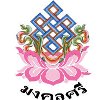Guru Rinpoche Day
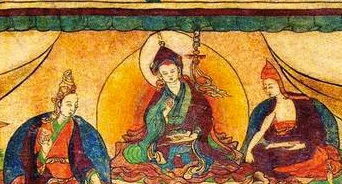
Beloved Friends Near and Far,
I hope you and your loved ones have been happy and healthy. I am at the moment in a small Malaysian city of Batu Pahat leading a Mahamudra retreat. And all is well here!
For today’s Guru Rinpoche Day, I thought of extracting few pith instructions by Padmasambhava to his close student, Trisong Detsen and a brief overview of how it all started.
How Padmakara came to the Snowy Land of Tibet.
It all started with Samye! The Great Lopon, Padmasambhava came to Tibet on the invitation of the Great King, Trisong Detsen under the guidance of the Great Abbot, Shantarakshita to built the first ever Buddhist monastery of the country.
When King Trisong Detsen, the thirty-eighth king of Tibet, was twenty-one years of age he formed a strong aspiration to spread the sacred teachings of the Dharma. He invited the Great Abbot; Shantarakshita from India who helped laid the foundation of the great temple. Whatever was build during the day was dismantled at night by the local spirits creating much obstacle which eventually lead the Abbot to make the prediction to invite the great master Padmasambhava to come to Tibet.
At the Tamarisk Forest at Red Rock, Padmakara met the king of Tibet and then proceeded to the top of Mount Hepori to bring the gods and demons of the country under his command. He laid the foundation for Samye and saw it through to completion, employing also the gods and demons who had earlier hindered the building. In five years the work was completed for the temple complex of Glorious Samye, the Unchanging and Spontaneously Accomplished Temple.
After the completion Samye, the King requested empowerment and instruction from Padmakara. At Chimphu, the hermitage above Samye, the great master gave profound teachings to many destined students headed by the king and his sons and the twenty-five disciples.
Guru Rinpoche remained in Tibet for 55 years and six months; 48 years while the king was alive and seven years and six months afterwards. He arrived when the king was 21 (810 A.D.). The king passed away at the age of 69. Padmakara stayed for a few years after that before leaving for Ngayab Ling by liberating the king of the Rakshasas and assuming his form at the Glorious Copper Colored Mountain of Glory.
Below is an excerpt of the extraordinary teachings given by the Master to the King.
Guru Rinpoche said this to Trisong Detsen:
To condense all into a single sentence: the view is to be free from convictions, meditation is to not place the mind on anything, experience is to be free from savoring the taste and fruition is beyond attainment. The Buddhas of the three times have not taught, are not teaching, and will not teach it to be any other than this!
(Advice from the Lotus Born pg. 38)
Guru Rinpoche to the King:
The awakened mind of bodhichitta is not created through causes nor destroyed through circumstances. It is not made by ingenious Buddhas nor manufactured by clever sentient beings. It is originally present in you as your natural possession. When you recognize it through your master’s oral instructions, since mind is the forefather of the Buddhas, it is like the analogy of recognizing someone you already know.
(Advice from the Lotus Born pg. 38)
King: What does it mean to ‘clear away the faults of conviction’?
Guru Rinpoche:
Even though you have realized that your mind is the Buddha, don’t forsake your master! Even though you have realized appearances to be mind, don’t interrupt conditioned roots of virtue! Even though you don’t hope for Buddhahood, honor the sublime Three Jewels! Even though you don’t fear samsara, avoid even the minutest misdeed! Even though you have gained the unchanging confidence of your innate nature, don’t belittle any spiritual teaching! Even though you experience the qualities of samadhi, higher perceptions and the like, give up conceit and pretentiousness! Even though you have realized that samsara and nirvana are nondual, don’t cease to have compassion for sentient beings!
(Advice from the Lotus Born pg. 39)
King: What does it mean to ‘gain certainty’?
Guru Rinpoche:
Gain certainty in the fact that since the very beginning your own mind is the awakened state of Buddhahood. Gain certainty in the fact that all phenomena are the magical display of your mind. Gain certainty in the fact that the fruition is present in yourself and is not to be sought elsewhere. Gain certainty in the fact that your master is the Buddha is person. Gain certainty in the fact that the nature of view and meditation is the realization of the Buddhas. Practice by means of such confidence.
(Advice from the Lotus Born pg. 39)
Sarva Mangalam,
Phakchok Rinpoche
www.phakchokrinpoche.org
www.cglf.org

We are pleased to announce that Kyabgon Phakchok Rinpoche will be leading a pilgrimage to the major sacred sites of Guru Rinpoche in Nepal and Sikkim, from 13 to 23 April this year. In total, we will be visiting ten sites, plus an optional trip to Maratika Caves. In each location, Rinpoche will be leading a tsok offering (or feast offering) associated with the Trinley Nyingpo (Guru’s Heart Practice, Dispeller of All Obstacles) from the Treasures of Chokgyur Lingpa.
Pilgrimage is a wonderful opportunity to connect our life and practice with the blessings of great enlightened ones who have consecrated these places. By visiting these sacred locations with the right frame of mind we can gather the two accumulations and remove our obscurations as taught by the Buddha.
This year’s pilgrimage will only be limited to twenty-five (25) persons, on a first come first serve basis. The closing date for registration is 23 March, 2012. To register, please visit http://www.cglf.org/news-a-events/foundation-events.html
CHOKGYUR LINGPA FOUNDATION
www.cglf.org
Lama Rinchen Phuntsok will be giving Dharma teaching on Guru Rinpoche’s PRAYER OF DIAMOND VERSES – The Prayer to Guru Rinpoche for Removing Obstacles and Fulfilling All Wishes (SOL DEB DORJEI TSIG KANG) on SATURDAY Jan 7th 2012 2pm-5pm.
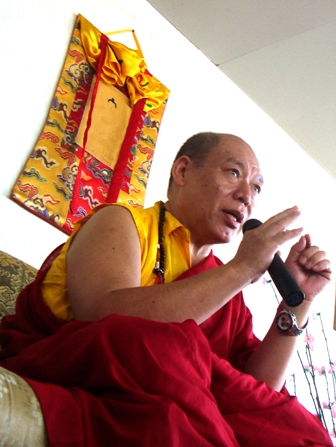
Location: Welcome palace apartment (ram’s home). For directions please see below. Please feel free to call ram at 0819855564 or contact us for more info and feel free to invite others who might be interested as well.
Date/Time: 2pm-5pm, Saturday 7th Jan 2012
RSVP: Please let us know if you’ll be coming by clicking “Attend” on the Dharma teaching on PRAYER OF DIAMOND VERSES by Lama Rinchen Phuntsok facebook page or contact us
This event is free of charge suitable for everyone from beginner to advanced practitioner.
Please come and join us, and if you wish, you could bring some vegetarian snacks and drinks which will be shared with others.
For those who have not met Lama Rinchen Phuntsok:
Venerable Lama Rinchen Phuntsok is a skillfull teacher with a light and joyful manner. He is a scholar and meditation master of the Tibetan Buddhist Tradition. Born in Tibet, Lama Rinchen began receiving instruction in the traditions of Tibetan Buddhism at the age of six in Tsasum Chokhorling Monastery in Tibet. After he left Tibet in 1958, he studied at Young Lama’s Home School in Dalhousie, The Buddhist Monastic School in Rewalsar, Nyingmapa Lama’s College in Dehra-Dun, and Zongdog Palri Monastery in Kalimpong. Lama Rinchen graduated from Sanskrit University in Varanasi India where he completed advanced studies in Sutrayana Buddhist philosophy and scriptures, commentaries, logic, literature, history, and the major sciences of the Tibetan curriculum. To complete his training in Vajrayana Nyingma School studies, he served as private secretary to the late His Holiness Dudjom Rinpoche, supreme Head of the Nyingma order of Tibetan Buddhism for over fifteen years. During that time he received all the important empowerments, transmissions, essential instructions, the oral teaching of Nyingma Kama, and the Profound Rediscovered Teachings of Terma of the great Lotus Born Teacher, Guru Padmasambhava, the founder of Vajravana Buddhism. For many years Lama Rinchen was in charge of Zangdog Palri Monastery in India and also Urgyen Dongag, Choling Monastery in Kathmandu, Nepal. In 1980, His Holiness Dudjom Rinpoche asked him to come to the United States to teach in his New York center where Lama Rinchen was director and resident Lama for four years. Since then he has lectured widely throughout the United States and Europe at centers, colleges, and universities. Lama Rinchen visits his students every year and stays in St. Louis to give teachings and empowerments for several weeks during his U.S. tour. He also has students in New York, California, Colorado, New Mexico, etc., as he continues to spread the teachings of the Dudjom Lineage.
(http://dongakcholing.org/LamaRinchen.html)
Directions: Welcome Palace Apartment (Ram’s place) on Naret rd. (a one way street), off of Sriphraya road. If you are coming by Sub-way (easiest) you can take the Samyan station exit in front of the temple then catch a Taxi or take a Motorbike Taxi (20 Baht) from there by telling them to go to Bangrak Police station. If coming by BTS you can get off at Saladaeng station and take a taxi from there as well. You can just tell the taxi to come to the Bangrak police station if you are coming directly from elsewhere. Once at the police station, my building is an old white building just before the station, come on the 12th floor on the right side and you’ll see a big door and I’ll be in there. If you see a lot of Africans in the building it means that you are in the right building.
Welcome Palace apartment
Show on Google Maps
ภาษาไทย ดูได้ที่นี่
Dear Friends Near and Far,Greetings to you all on this Guru Rinpoche Day. I hope you’ve all be healthy and happy.We all want to be happy. This is our fundamental aim in life, right? But often we find it difficult to achieve. When we don’t know how to deal with our own emotions and our mind then sometimes life can become very tiring and depressing. On top of that, most of us are so busy these days, which makes us even more stressed and uptight. So here I would like to share with you three simple ways that helps me deal with my emotions and thus gives me comfort.1. Creating Space
These days we have so many things to think about: our health, our family, our work, and if you’re a dharma practitioner, then on top of all that you have meditation and dharma practice to worry about. When we don’t know how to deal with them, these worries can make our minds start to slowly shrink, becoming more and more narrow, and as a consequence more and more negative. Sometimes things start to overwhelm us and we feel trapped physically. Our chest feels tight and then we let out a big sigh in an attempt to relieve ourselves of these feelings. That happens sometimes. A small problem can come to seem so big that we can’t deal with it at all.
A really good way to deal with this is to create space mentally. It helps relieve the tension and uptightness in your mind and in your body as well. Creating space is a very simple method. It’s not a Buddhist teaching or anything like that. It’s simply a technique we can apply to give ourselves space and freedom and relief from all our worrisome thoughts.
How to create space? When you have a few minutes, look ahead of you and simply imagine that you’re surrounded by empty space in all directions. Sometimes it is useful to look at the empty sky. Just imagine space everywhere: no walls, no boundaries, no buildings, nothing. And don’t start thinking about work, family, things you need to do. Simply imagine that everything is just like the vast, open sky, like empty space, and let your mind blend into the space so that it becomes just as vast and open. You can close your eyes if that helps. Imagine this spaciousness for a short while. After a minute or two you’ll start to really feel spacious mentally. Your chest will open up and you’ll feel relieved of all those tensions and thoughts that were crowding in on you just a few minutes ago. Your mind opens up and then your way of thinking changes, just like that. It takes just five or ten minutes and is so easy—that is the magic of creating space. You don’t have to believe me. Try it for yourself and you’ll see.
2. Knowing your own faults and Reducing Judgment
We all want to be happy, right? Yes or no? But what is our mind occupied with most of the time? Negative emotions, negative judgments, and negative thoughts. Look at your own mind and see the pattern of emotions. How many of them are negative? Have you ever before given this a moment’s thought?
So what you need to do first is to recognize your thought-patterns, your negative emotions and the way they arise, the way different feelings arise. Recognize, notice, but Don’t Judge. There’s a big difference between noticing and judgment. Noticing is simply recognizing and becoming aware of something: “Oh, yes, I have a problem with jealousy.” But judgment goes one step further—a step too far—and starts criticizing: “Oh, yes, I have a problem with jealousy. Oh my God, I’m such a bad person. I can’t believe I made that mistake! Oh, I feel so awful. I can’t bear it!….” Do you see the difference? Judgment has these emotional ties whereas noticing does not. So try to simply notice your faults and not judge.
The problem nowadays is not that people are not doing dharma or other spiritual practice and trying to improve. The problem nowadays is that we don’t notice and accept our own faults; so then of course we don’t improve, no matter how we might try. It’s a bit like taking medicine for an illness when you don’t even know what illness you have. So please give this a moment’s thought. Look honestly at yourself and acknowledge your own faults and mistakes.
3. Compassion and Loving Kindness
The third key I’d like to mention here is having compassion and loving-kindness. Traditionally speaking, in the Buddha’s teaching, compassion is defined as the wish for beings to be free from suffering and the cause of suffering and loving kindness is the wish for beings to have happiness and the cause of happiness. Here though, I’d like to explain compassion as meaning a basic understanding or empathy for others and loving kindness as meaning a good, kind heart.
Understanding is so important. For example, in order for a family to be happy and harmonious the parents need to understand their children, be able to see things from their point of view, and the children also need to understand their parents. It’s the same in all situations, in the office, other relationships and so on. We need to share with each other, get to know each other well, and learn to look at things from others’ perspectives; we need to put ourselves in their shoes. If somebody is shouting at you, do you think he’s happy? Do you think he’s enjoying that? No, he’s upset, stressed, and angry, and later on he might well feel a lot of regret for what he’s doing right now. Yes, many people make mistakes, but do you think they do so intentionally? Do you think they do so because they’re happy? No. So try to understand that instead of just reacting with more anger and judgment from your side. If you can do that, you’ll feel compassion.
Another aspect of compassion is that if you come to understand your own problems and gain some freedom from them, naturally compassion towards others will arise. On the other hand, when you don’t clearly notice your own problems in the first place and know what suffering you have then how can you have compassion for others? How can you wish others to be free from that suffering, suffering that you don’t even recognize clearly yourself? So first you need to see your own problem. How? When you create space, the first key, and gain some freedom from your stress and the onslaught of thoughts, you see what you’re getting out from, you see the benefits of how you become happier. From just the first point, creating space, you think, “Oh, my boss, poor guy. If he knew this method he would be in a much better place than he is now. The poor guy.”
When you have this kind of compassion, your mind becomes more and more loose. When you focus more on others, indirectly you’re reducing your focus to your ego and as a result your mind then becomes more and more relaxed, more expansive and then more intelligent. You can share these three points with anyone. It’s going to benefit them, not harm them. So these are the three keys to be happy.
Sending you all much love and affection.
Sarva Mangalam,
Phakchok Rinpoche |
|
|
|
กุญแจสู่ความสุข
แด่สหายทั้งหลายที่อยู่ใกล้และอยู่ไกล สวัสดีทุกท่านเนื่องในวันคุรุรินโปเช หวังว่าทุกท่านคงมีสุขภาพที่ดีและมีความสุข เราทุกคนล้วนต้องการจะมีความสุข สิ่งนี้คือเป้าหมายพื้นฐานในชีวิตเราจริงหรือไม่? แต่บ่อยครั้งที่เรารู้สึกว่าเป็นการยากลำบากเหลือเกินที่จะเข้าถึงความสุข เมื่อใดก็ตามที่เราไม่รู้ว่าจะรับมือกับอารมณ์และจิตใจของเราอย่างไร เมื่อนั้นเราจะรู้สึกว่าชีวิตช่างน่าเหนื่อยหน่ายและตึงเครียด ด้วยเหตุนั้นในที่นี้ข้าพเจ้าจึงอยากมีส่วนร่วมกับท่านทั้งหลายในวิถีทางสามเรื่องง่ายๆ ที่ช่วยให้ข้าพเจ้าสามารถจัดการกับอารมณ์และความรู้สึกของข้าพเจ้า ซึ่งทำให้ข้าพเจ้าสุขสบายอยู่เสมอ
ทุกวันนี้เรามีสิ่งที่ต้องคิดคำนึงถึงมากมายเหลือเกิน ทั้งเรื่องสุขภาพ ครอบครัว หน้าที่การงาน และถ้าท่านเป็นผู้ฝึกปฏิบัติธรรมด้วยแล้วท่านยังมีภาระในการทำสมาธิและฝึกปฏิบัติธรรมที่ต้องเป็นห่วงอีก เมื่อใดก็ตามที่เราไม่รู้ว่าจะจัดการกับมันอย่างไรความกังวลนี้จะทำให้จิตใจของเราหดตัวลงที่ละน้อยๆ และมีขนาดแคบลงๆ ผลลัพธ์ที่เกิดขึ้นจะเป็นไปในทางเลวร้ายยิ่งขึ้นเรื่อยๆ จนบางครั้งดูเหมือนว่าสิ่งต่างๆ เริ่มท่วมท้นหนักหน่วงจนรู้สึกเหมือนกำลังติดกับดักและยังรู้สึกแน่นหน้าอก เราจะแสดงออกอย่างชัดเจนถึงความพยายามที่จะผ่อนคลายตัวเองจากความรู้สึกเหล่านั้น สิ่งนี้คงเกิดขึ้นกับเราบ้างในบางครั้งไม่มากก็น้อย แต่เรื่องเล็กๆ เหล่านี้ก็อาจกลายเป็นปัญหาใหญ่ที่เราไม่สามารถจัดการกับมันได้
วิธีการที่ยอดเยี่ยมประการหนึ่งในการจัดการกับสิ่งเหล่านี้คือการสร้างพื้นที่ว่างทางจิตใจขึ้น วิธีนี้จะช่วยปลดปล่อยอกุศลเจตนาและความตึงเครียดทั้งในจิตใจเช่นเดียวกับในร่างกายของท่าน การสร้างพื้นที่ว่างมีวิธีการที่ง่ายมาก มันไม่ใช่การสอนคำสอนทางพุทธศาสนาหรืออะไรทำนองนั้น หากเป็นเทคนิคง่ายๆ ที่เราสามารถประยุกต์ใช้กับพื้นที่ว่างและอิสรภาพของเรา และปลดปล่อยเราจากความกังวลทั้งมวล
แล้วเราจะสร้างที่ว่างได้อย่างไร? หากท่านมีเวลาสักเล็กน้อยลองมองตรงไปข้างหน้าและจินตนาการว่าท่านกำลังถูกล้อมรอบด้วยที่ว่างทุกทิศทุกทาง หากจำเป็นบางครั้งก็อาจใช้วิธีมองขึ้นไปบนท้องฟ้าที่ว่างเปล่า เพียงแค่จินตนาการว่าทุกหนทุกแห่งล้วนเป็นที่ว่าง ไม่มีกำแพง ไมมีขอบเขต ไม่มีตึกรามบ้านช่อง ไม่มีอะไรเลย และอย่าเริ่มต้นคิดถึงการงาน ครอบครัว คิดถึงเฉพาะสิ่งที่ท่านต้องการจะทำ จินตนาการง่ายๆ ว่าทุกสิ่งทุกอย่างล้วนเป็นพื้นที่ว่างกว้างใหญ่ ฟ้าโปร่งเหมือนที่ว่าง และปล่อยให้จิตใจของท่านผสมกลมกลืนไปกับพื้นที่ว่างดังกล่าวจนกลายเป็นพื้นที่ว่างและเปิดโล่งสุดลูกหูลูกตา ท่านอาจจะหลับตาลงหากสิ่งนี้ช่วยท่านได้ จินตนาการถึงความว่างเปล่านี้สักอึดใจหนึ่ง หลังจากเวลาผ่านไปสักนาทีหรือสองนาทีท่านจะเริ่มรู้สึกถึงความว่างในจิตใจอย่างแท้จริง หน้าอกของท่านจะโล่งและท่านจะรู้สึกถึงความผ่อนคลายจากความตึงเครียดในหัวท่านก่อนหน้านี้ จิตใจของท่านจะเปิดออกเช่นเดียวกับวิธีคิดของท่านที่จะเปลี่ยนไปเช่นกัน ขั้นตอนเหล่านี้ใช้เวลาไม่มากเลยเพียงห้าหรือสิบนาทีและยังง่ายมากด้วย นั่นแหละคือความวิเศษของการสร้างที่ว่าง ท่านไม่จำเป็นต้องเชื่อฉันแต่ลองดูด้วยตนเองแล้วท่านจะรู้สึกได้ด้วยตนเอง
- 2) เรียนรู้ข้อผิดพลาดของตนเองและลดการตัดสิน
เราทุกคนล้วนต้องการจะมีแต่ความสุขจริงหรือไม่ แต่อะไรคือสิ่งที่จิตใจของเรายึดติดอยู่ตลอดเวลา? นั่นคือความรู้สึกในด้านลบ การตัดสินในเด้านลบ และความคิดในด้านลบ ลองย้อนมองเข้าไปในจิตของท่านและศึกษาถึงรูปแบบของอารมณ์ดังกล่าวว่ามีมากน้อยเพียงใดที่อยู่ในด้านลบ ท่านเคยคำนึงถึงเรื่องนี้สักเล็กน้อยบ้างไหม?
ดังนั้นสิ่งที่ท่านต้องทำประการแรกคือตระหนักและยอมรับในรูปแบบหรือกระบวนการความคิดของท่าน โดยเฉพาะอย่างยิ่งความรู้สึกในด้านลบของท่านและกระบวนการที่ก่อให้เกิดความรู้สึกดังกล่าว หรือกระบวนการที่ความรู้สึกต่างๆ บังเกิดขึ้น การยอมรับในที่นี้คือการสังเกตเห็นโดยไม่ต้องตัดสินอะไรใดๆ ทั้งสิ้น เป็นเรื่องสำคัญที่จะต้องทราบถึงความแตกต่างระหว่างการสังเกตเห็นกับการตัดสิน การสังเกตเห็นคือการตระหนักถึงสิ่งใดสิ่งหนึ่งอย่างเรียบง่าย เช่นคำกล่าวว่า “โอ้ ใช่เลย ฉันมีปัญหากับความเป็นคนขี้อิจฉาของฉัน” ส่วนการตัดสินมักจะก้าวเลยไปก้าวหนึ่งเสมอซึ่งส่งผลไปสู่การวิพากษ์วิจารณ์ชี้ถูกชี้ผิด ดังประโยคที่กล่าวว่า “โอ้ ใช่เลย ฉันมีปัญหากับความขี้อิจฉาของฉัน ฉันมันเลวสิ้นดี ไม่น่าเชื่อว่าฉันจะทำผิดพลาดได้เช่นนั้น โอ้ ฉันช่างงี่เง่าจริงๆ ทนไม่ไหวแล้ว…” ท่านเห็นความแตกต่างดังกล่าวบ้างไหม การตัดสินนั้นเกี่ยวข้องกับอารมณ์ขณะที่การสังเกตเห็นนั้นไม่ ดังนั้นให้ท่านหัดสังเกตง่ายๆ ถึงความผิดพลาดของท่านโดยไม่จำเป็นต้องตัดสิน ปัญหาทุกวันนี้ไม่ใช่เรื่องที่เราหันหลังให้กับการปฏิบัติธรรมหรือการฝึกฝนทางจิตต่างๆ หรือมีปัญหาที่ต้องพยายามปรับปรุงให้ดีขึ้น ไม่ว่าเราจะพยายามอย่างหนักมาแล้วเพียงไรก็ตาม เพราะนั่นเปรียบเสมือนการกินยารักษาโรคโดยที่ยังไม่รู้ว่าตนป่วยด้วยสาเหตุใด ดังนั้นโปรดหยุดคิดสักนิดหนึ่งโดยการหันเข้าไปมองตนเองด้วยความสัตย์จริงว่าเรามีข้อผิดพลาดอะไรบ้าง
กุญแจสำคัญดอกที่ 3 ที่ฉันอย่ากจะกล่าวถึงในที่นี้คือความกรุณาและเมตตา ถ้าถือตามหลักเกณฑ์คำสั่งสอนในพุทธศาสนา กรุณาหมายถึงความปรารถนาที่จะให้สรรพสัตว์เป็นอิสระจากความทุกข์และเหตุแห่งความทุกข์ และเมตตาก็คือความปรารถนาที่จะให้สรรพสัตว์มีความสุขและเหตุของความสุข ในที่นี้ฉันจึงอยากจะอธิบายว่ากรุณาหมายถึงความเข้าใจพื้นฐานหรือการเห็นอกเห็นใจผู้อื่น ขณะที่เมตตาหมายถึงการมีจิตใจดี
ความเข้าใจเป็นสิ่งสำคัญอย่างยิ่ง ตัวอย่างเช่นในครอบครัวที่มีความสุขและปรองดองกัน บิดามารดาก็จำเป็นต้องเข้าใจบุตรหลานของตน ต้องมองสิ่งต่างจากมุมมองของพวกเขา และบุตรหลานก็จำเป็นต้องเข้าใจผู้ปกครองของตนในทำนองเดียวกัน ความสัมพันธ์เช่นนี้สามารถสร้างขึ้นได้ในทุกสถานที่และทุกเวลาไม่ว่าจะเป็นในที่ทำงานหรือเป็นความสัมพันธ์ชนิดอื่นๆ ก็ตาม เราจำเป็นต้องมีการแลกเปลี่ยนซึ่งกันและกัน พยายามทำความรู้จักซึ่งกันและกัน และหัดมองสิ่งต่างๆ จากมุมมองของผู้อื่น พูดอย่างติดตลกได้ว่าเราต้องหัดใส่รองเท้าของคนอื่นบ้าง หากมีใครมาตะโกนด่าว่าคุณคุณจะคิดว่าเขากำลังมีความสุขอยู่หรือ? คุณคิดว่าเขาสนุกกับการกระทำเช่นนั้นหรือ? เปล่าเลย เขากำลังกลัดกลุ้ม เครียด และโกรธ แต่เมื่อเวลาผ่านไปเขาจะรู้สึกเสียใจไม่น้อยกับการกระทำของตัวเอง ใช่แล้วหลายคนทำผิดพลาด แต่ท่านคิดว่าเขาใช้อารมณ์มากเกินไปหรือเปล่า? ท่านคิดว่าเขาทำลงไปเพราะเขามีความสุขหรือ? ไม่เลย ดังนั้นท่านควรพยายามใช้ความเข้าใจแทนที่จะมีอารมณ์โกรธตอบและด่วนตัดสินจากมุมมองของท่าน ถ้าท่านปฏิบัติได้ดังนี้ก็ถือได้ว่าท่านมีความกรุณาแล้ว
ในอีกมุมหนึ่งของความกรุณาก็คือหากท่านสามารถเข้าใจถึงปัญหาทั้งหลายของตัวเองและสามารถปลดปล่อยตนเองจากสิ่งเหล่านั้นได้ ความกรุณาต่อผู้อื่นก็จะเพิ่มขึ้นโดยอัตโนมัติหรือโดยเป็นธรรมชาติ ในทางตรงกันข้ามหากท่านไม่สามารถจัดการกับข้อสังเกตในปัญหาของท่านเอง ณ ที่ที่มันก่อตัวขึ้น และรู้ว่าท่านต้องทุกข์ทนอย่างไร แล้วท่านจะมีความกรุณาต่อผู้อื่นได้อย่างไร ท่านจะหวังให้ผู้อื่นเป็นอิสระจากความทุกข์ได้อย่างไร ความทุกข์ซึ่งท่านเองยังไม่แม้แต่จะตระหนักรู้โดยชัดเจนได้ ดังนั้นสิ่งแรกสุดคือการมองเห็นปัญหาของตนเอง คำถามต่อมาคือแล้วอย่างไร? เมื่อท่านสร้างพื้นที่ว่างซึ่งเป็นกุญแจประการแรกสำเร็จ และค้นพบอิสระจากความเครียดและการจู่โจมของความคิดต่างๆ ท่านจะเห็นได้ว่าท่านสามารถพ้นออกมาจากสิ่งใด ท่านเห็นถึงคุณประโยชน์ว่าท่านมีความสุขได้อย่างไร จากจุดแรกสุดคือการสร้างพื้นที่ว่าง ท่านจะคิดใหม่ว่า “โอ้ หัวหน้า ถ้าเขาทราบวิธีการนี้เขาจะดีขึ้นกว่านี้มาก คนน่าสงสาร”
เมื่อใดก็ตามที่ท่านมีความกรุณาเช่นนี้จิตใจของท่านก็จะเบาและเป็นอิสระขึ้นเรื่อยๆ เมื่อใดก็ตามที่ท่านหันไปเพ่งพิจารณาถึงคนอื่นๆ แทนที่จะเป็นเรื่องของตัวเอง ท่านจะสามารถลดอัตตาหรืออีโก้ลง ผลที่ได้ต่อจิตใจของท่านก็คือความผ่อนคลายที่เพิ่มมากขึ้น รู้สึกเปิดกว้างขึ้น และปัญญาเพิ่มพูนมากขึ้น ท่านสามารถแลกเปลี่ยนกุญแจทั้งสามนี้กับคนอื่นๆ ต่อไปเพราะเป็นสิ่งที่มีแต่คุณประโยชน์ไม่เป็นพิษภัยต่อพวกเขา และนี่คือกุญแจสามดอกไปสู่ความสุข
ด้วยความรักและปรารถนาดี
สรรวะมังคะลัม
พักชก รินโปเช (Phakchok Rinpoche)

“Vajrasattva: Teachings and Practice”
Retreat in December 2011 with
Venerable Lama Rinchen Phuntsok
Huahin, Thailand (3 hrs South of Bangkok)
How are you doing? Hope you all are doing well. I hope you all remember Lama Rinchen Phuntsok who came to give Dharma teaching in July in Bangkok.
This retreat is for all levels of practitioners from beginner to advanced, all can join.
For those who haven’t met him:
Venerable Lama Rinchen Phuntsok is a skillfull teacher with a light and joyful manner. He is a scholar and meditation master of the Tibetan Buddhist Tradition. Born in Tibet, Lama Rinchen began receiving instruction in the traditions of Tibetan Buddhism at the age of six in Tsasum Chokhorling Monastery in Tibet. After he left Tibet in 1958, he studied at Young Lama’s Home School in Dalhousie, The Buddhist Monastic School in Rewalsar, Nyingmapa Lama’s College in Dehra-Dun, and Zongdog Palri Monastery in Kalimpong. Lama Rinchen graduated from Sanskrit University in Varanasi India where he completed advanced studies in Sutrayana Buddhist philosophy and scriptures, commentaries, logic, literature, history, and the major sciences of the Tibetan curriculum. To complete his training in Vajrayana Nyingma School studies, he served as private secretary to the late His Holiness Dudjom Rinpoche, supreme Head of the Nyingma order of Tibetan Buddhism for over fifteen years. During that time he received all the important empowerments, transmissions, essential instructions, the oral teaching of Nyingma Kama, and the Profound Rediscovered Teachings of Terma of the great Lotus Born Teacher, Guru Padmasambhava, the founder of Vajravana Buddhism. For many years Lama Rinchen was in charge of Zangdog Palri Monastery in India and also Urgyen Dongag, Choling Monastery in Kathmandu, Nepal. In 1980, His Holiness Dudjom Rinpoche asked him to come to the United States to teach in his New York center where Lama Rinchen was director and resident Lama for four years. Since then he has lectured widely throughout the United States and Europe at centers, colleges, and universities. Lama Rinchen visits his students every year and stays in St. Louis to give teachings and empowerments for several weeks during his U.S. tour. He also has students in New York, California, Colorado, New Mexico, etc., as he continues to spread the teachings of the Dudjom Lineage.
(http://dongakcholing.org/LamaRinchen.html)
Retreat in Huahin, Thailand
2 days retreat (Cost: Baht 500, 1 night stay included along with all meals)
-The 2 days session will start on Saturday December 24th and ends on Sunday December 25th .
9 days retreat (Cost: Baht 2000, 8 nights stay included along with all meals)
-The 9 days session will the continuation from the 2 days retreat which starts on December 24th and will end on January the 1st 2012.
Location: Rai rak thamma-chat west of Huahin downtown about 45 minutes by public bus. If you are coming from Huahin town, take public transport (a truck with roof on the back) to Pa-la-oo waterfall and on the way you’ll see Tibetan temple on the left side, about 500 meters past that on the right side is the outer entrance to the retreat center area, come inside until you meet us.
Note
- The above costs do not include transportation cost from Bangkok to Huahin and back. As soon as we find out the number of participants then we will inform you the transport costs.
- In the case where there are not enough cabins for everyone then accommodation will be provided in tents. So if you can bring tents for yourself and others, please let us know, we might need to borrow them.
Overseas participants:
If you’ll be coming to this retreat from overseas then please contact us and let us know your travel plans so we can assist you properly.
Vajrasattva practice is very much related to purification of all negative karma which we have committed in this life and countless lives before. So this is a very powerful and useful practice.
In the past, while on the path of learning, Vajrasattva made the following aspiration: (from Rigpawiki)
In future, when I reach complete and perfect buddhahood, may those who have committed the five crimes with immediate retribution, or anyone whose samaya commitments have been impaired, be purified entirely of all their harmful actions and impairments merely by hearing my name, thinking of me, or reciting the hundred syllables, the most majestic of all the secret mantras! Until this is brought about may I remain without awakening!
And:
May I be present before all those with impairments and breakages of samaya commitments and may I purify all their obscurations!
Signing up
(Please note that the number of places are limited so please sign up immediately so we can reserve a place for you, also note that we might be sleeping in tents if cabin runs out, so if you have tents please bring them along.)
To sign up, please email ram@pluslab.com with the following information:-
Full name:
Contact telephone number:
Emergency contact/next of kin contact information:
Special request/requirement:
2 days (Baht 500) or 9 days (Baht 2000) retreat:
For more information please email ram@pluslab.com or call Ram at 081-9855564
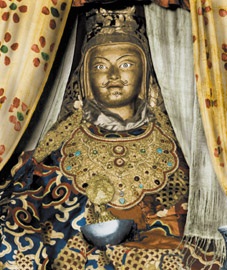
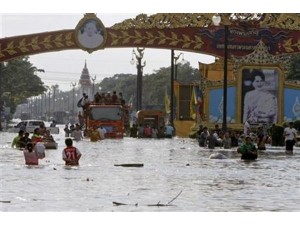
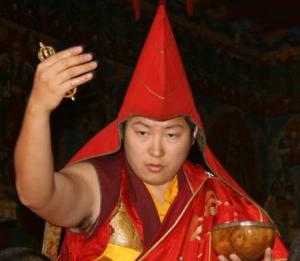
(October 15 2011)
Rinpoche and ourselves have been keeping ourselves updated regarding the situation in Thaliand via the BBC News. Rinpoche reassures the Thai sangha that you are all in Rinpoche’s prayers and aspirations always. Rinpoche advises all of you to make fervent supplications to Guru Rinpoche, and to have very strong faith in Guru Rinpoche during these difficult times.
With compassions and prayers,
Gem
On behalf of Phakchok Rinpoche
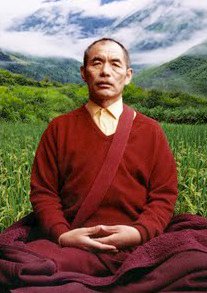
Dear Dharma Brothers and Sisters,
I hope you are all well and peacefully wandering through saṁsāra. As I write this monthly message to you all, I have all these thoughts going through my mind. Oh oh..it’s almost nearing midnight…but then in Asia it’s already the 11th…are people actually reading these messages?…or even opening them?…hmmm…and if they do actually read it, does it make any sense to them?…is this helping them in anyway possible?…alright concentrate, you only have half an hour left before it turns midnight! But if I look at the bigger picture, if i can impact one friend to remember the practice and remember the Dharma on this GRD, I am one step closer.
So, please remember your practice and remember the Dharma. Right now I, the wandering, crazy, half-cooked Yogi, am thinking of my teacher and remembering his teachings like an old widow who lost her husband. Today is the first day of the Nine Yanas retreat of the Bodhisattva Level, here at Gomde Cooperstown. Today is a joyous day for double celebration as today marks the miraculous birth of Guru Rinpoche in a lotus bed on Lake Danakosha and also the birthday of my father, Tsikey Chokling. We sealed the day with bountiful Tsok offering and aspirations for the happiness and wellbeing of all sentient beings.
My teachings today will be the heartfelt teachings from my loving Guru, secret Yogi, Nyoshul Khen Rinpoche. He said, remembering our motivation is most important. He said, our motivation can be represented by the five fingers of the hand.
First we start with the little finger, the pinky. This is the smallest finger and in Tibetan culture considered the most offensive. The pinky has two meanings, the first is the motivation of being free from fear in this life. The second is for worldly success and pleasure.
The ring finger is neutral. Not virtuous nor non-virtuous. For example, being motivated by others or social influence. Like when being invited to a retreat by a friend and going, “just to check it out.”
The middle finger represents the motivation of wanting to be free from the three lower realms. Another way to say this is avoiding the ten non-virtuous acts.
The index finger represents the motivation of wanting freedom from saṁsāra. The individual liberation path.
Finally, we arrive at the thumb. The thumb represents the most supreme motivation, Bodhicitta. This is practicing for the benefit of all sentient beings so they too may be free from saṁsāra and suffering.
Please be mindful in your practice, don’t forget compassion and the view of emptiness. And most important, check your motivation as I mentioned above.
I send you love and my prayers. May your virtue increase. May your Dharma dignity become firmly established. May your understanding of emptiness become luminous.
Sarva Mangalam,
Phakchok Rinpoche

